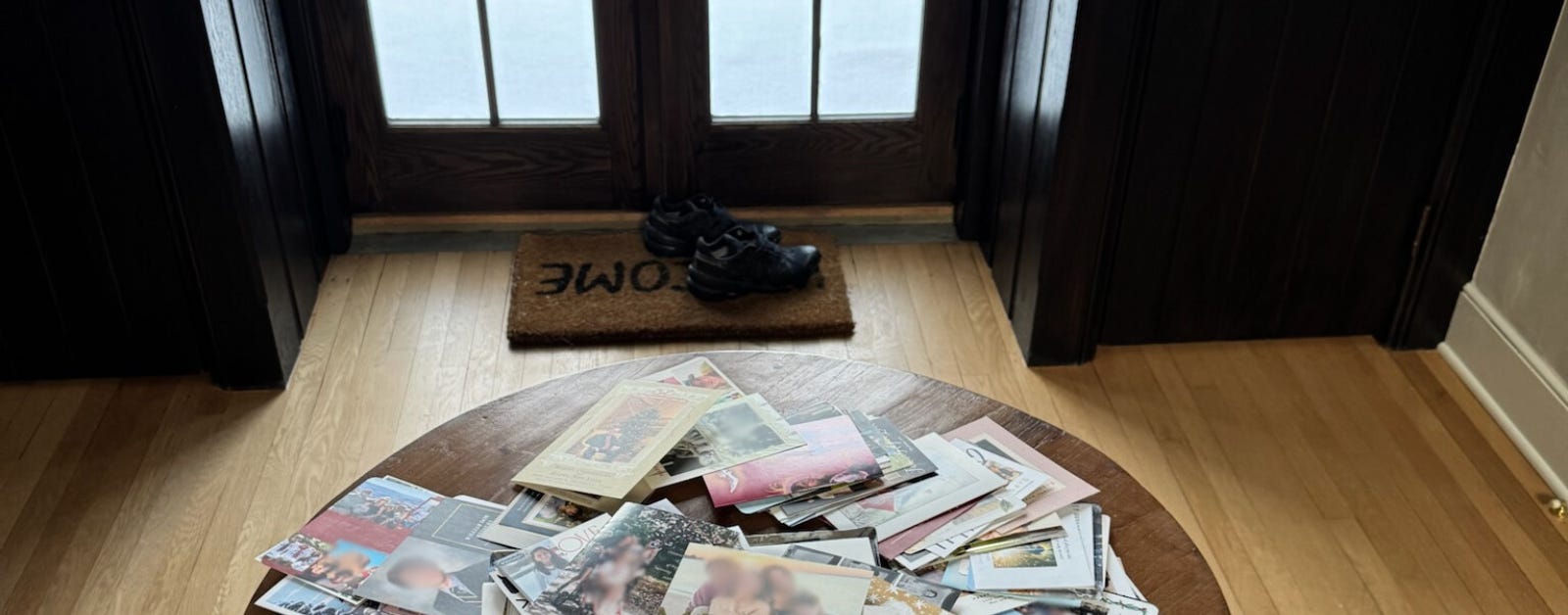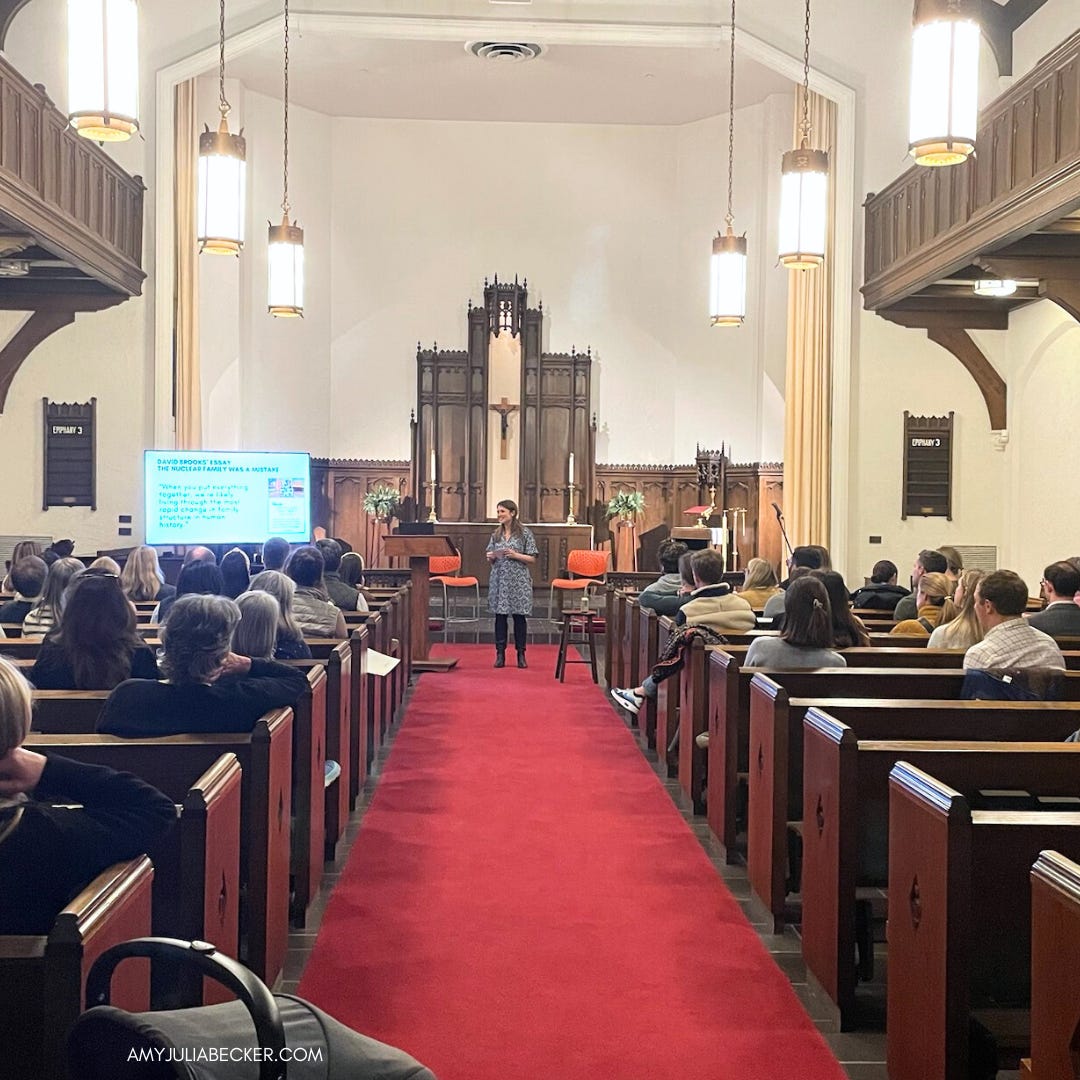Our front hall table is still covered in holiday cards. There are the uber-organized people who sent their cards at Thanksgiving, then the steady stream of happy faces that arrived throughout the month of December. There are cards like ours, which may have landed in mailboxes on December 23 or 24, just in time for Christmas. The ones that trickled in after the fact, and then those that didn’t pretend and just proclaimed, “Happy New Year!” I’m waiting for a few Valentine’s Day stragglers.

Last week, I traveled to the Church of the Incarnation in Dallas, Texas, to talk about reimagining the good life for our children. I started my talk with this table of holiday cards.

The cards tell a story of happiness and order, with kids in matching outfits and so many big, bright smiles. Our family’s card sends the same message—that all is bright and cheery and well with us. There’s truth to the cheer—and there’s also a darker side, to each of our individual families, and to the state of American families in general. (I wrote, for example, about the isolation that Penny, our daughter who has Down syndrome, has experienced at various points in her life, which of course our Christmas card does not convey.)
Books like Jennifer Breheney Wallace’s Never Enough and Jonathan Haidt’s Anxious Generation detail the increasing rates of anxiety, depression, self-harm, and pressure adolescents feel. Reports like Vivek Murthy’s “Parents Under Pressure” underline the way parents also feel more stress than ever before. There’s a disconnect between our cheery posts and cards and the stress both teenagers and parents express when asked.
Is there another way?
For families under pressure…
As any regular reader of this newsletter knows, I keep circling back to the idea of “reimagining.” That’s where I landed with this talk in Texas too. That yes, there is a different way to navigate the pressures of modern family life, but it takes reimagining. Reimagining who our kids are and our role in their lives. Reimagining who God is and God’s role in our lives. And reimagining our identity as a family so that we are moving not toward success but toward flourishing.
Reimagining Our Children
I heard Alison Gopnik talk about her book The Gardener and the Carpenter with Ezra Klein years ago, but I finally bought it to read for myself because the concept aligns so deeply with the way I want to see our kids. They aren’t construction projects that I fashion in my image. Rather, our kids are seeds that already contain material to become who they are. But they need good conditions in order to flourish. My job as a parent is to tend their growth—spiritual, mental, emotional, physical—well. To notice the things they love and the times they seem anxious (for our kids, that shows up more with stomach aches and colds than with a direct expression of feeling stressed out). To encourage self-reflection. To embrace their limitations and explore their possibilities. To reimagine who they are, beginning with their belovedness.
Reimagining God
I wrote extensively about this in To Be Made Well, but it’s worth repeating that the primary way Jesus addresses God (and invites us to address God) is as a good, loving father. (This of course can be really hard for some of us when we’ve had absent/distant/neglectful or abusive fathers, but the image is meant to convey a father who is present, safe, and unendingly loving.) As parents, we are invited to know ourselves as needy, dependent, beloved children. We are invited to reimagine ourselves as ones who don’t have to get it all right. As ones who don’t have to be in control. As ones who need to receive our own belovedness repeatedly so we can live from that place.
Reimagining Family Identity
Reimagining who our kids are and reimagining who God is allows us to also reimagine our families. Instead of being stuck in a constant state of striving to prove ourselves through appearance, ability, and awards, we can take delight in who we are becoming in love. We can show compassion rather than judgment when we—or our children—don’t seem to measure up to our peers.
Growth, not Perfection
I loved meeting with parents of kids with disabilities and parents of typically developing kids and realizing that all of us are seeking to love our kids well. None of us will do it perfectly. All of us will regret things we say or do. But if and as we return to love—our own belovedness and the belovedness of each of our kids too—we will grow into the people we are created to be.
How have you nurtured growth over perfection in your family? In what ways do you want to reimagine family life? I’d love to hear from you!
Blessings,
Amy Julia
P.S. I was asked a few great questions at the end of the gathering in Dallas, including, “What are some specific things I can do to delight in my child?” You can read my answer here.
MORE WITH AMY JULIA:
- Free Resource: From Exclusion to Belonging
(a free guide to help you identify and create spaces of belonging and welcome) - Family Game Time: The Name Game
Let’s stay in touch. Subscribe to my newsletter to receive weekly reflections that challenge assumptions about the good life, proclaim the inherent belovedness of every human being, and envision a world of belonging where everyone matters. Follow me on Facebook, Instagram, and YouTube and subscribe to my Reimagining the Good Life podcast for conversations with guests centered around disability, faith, and culture.
This post contains affiliate links.



